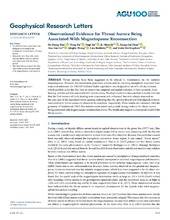| dc.contributor.author | Han, De-Sheng | |
| dc.contributor.author | Xu, Tong | |
| dc.contributor.author | Jin, Yaqi | |
| dc.contributor.author | Oksavik, Kjellmar | |
| dc.contributor.author | Chen, Xiangcai | |
| dc.contributor.author | Liu, Jian-Jun | |
| dc.contributor.author | Zhang, Qinghe | |
| dc.contributor.author | Baddeley, Lisa | |
| dc.contributor.author | Herlingshaw, Katie | |
| dc.date.accessioned | 2020-05-15T10:57:31Z | |
| dc.date.available | 2020-05-15T10:57:31Z | |
| dc.date.issued | 2019 | |
| dc.Published | Han D, Xu T, Jin Y, Oksavik K, Chen X, Liu J, Zhang Q, Baddeley L, Herlingshaw K. Observational evidence for throat aurora being associated with magnetopause reconnection. Geophysical Research Letters. 2019;46(13):7113-7120 | eng |
| dc.identifier.issn | 1944-8007 | en_US |
| dc.identifier.issn | 0094-8276 | en_US |
| dc.identifier.uri | https://hdl.handle.net/1956/22287 | |
| dc.description.abstract | Throat auroras have been suggested to be related to indentations on the subsolar magnetopause. However, the indentation generation process and the resulting ionospheric responses have remained unknown. An EISCAT Svalbard Radar experiment was designed to run with all‐sky cameras, which enabled us for the first time to observe the temporal and spatial evolution of flow reversals, Joule heating, and ion upflows associated with throat aurora. The high‐resolution data enabled us to discriminate that the flow bursts and Joule heating were concurrent and co‐located, but were always observed on the west side of the associated throat auroras, reflecting that the upward/downward field‐aligned currents associated with throat aurora are always to the east/west, respectively. These results are consistent with the geometry of Southwood (1987) flux transfer event model and provide strong evidence for throat aurora being associated with magnetopause reconnection events. The results also support a conceptual model of the throat aurora. | en_US |
| dc.language.iso | eng | eng |
| dc.publisher | AGU | en_US |
| dc.title | Observational evidence for throat aurora being associated with magnetopause reconnection | en_US |
| dc.type | Peer reviewed | |
| dc.type | Journal article | |
| dc.date.updated | 2019-11-22T10:07:20Z | |
| dc.description.version | publishedVersion | en_US |
| dc.rights.holder | Copyright 2019. American Geophysical Union. All Rights Reserved. | en_US |
| dc.identifier.doi | https://doi.org/10.1029/2019gl083593 | |
| dc.identifier.cristin | 1721452 | |
| dc.source.journal | Geophysical Research Letters | |
